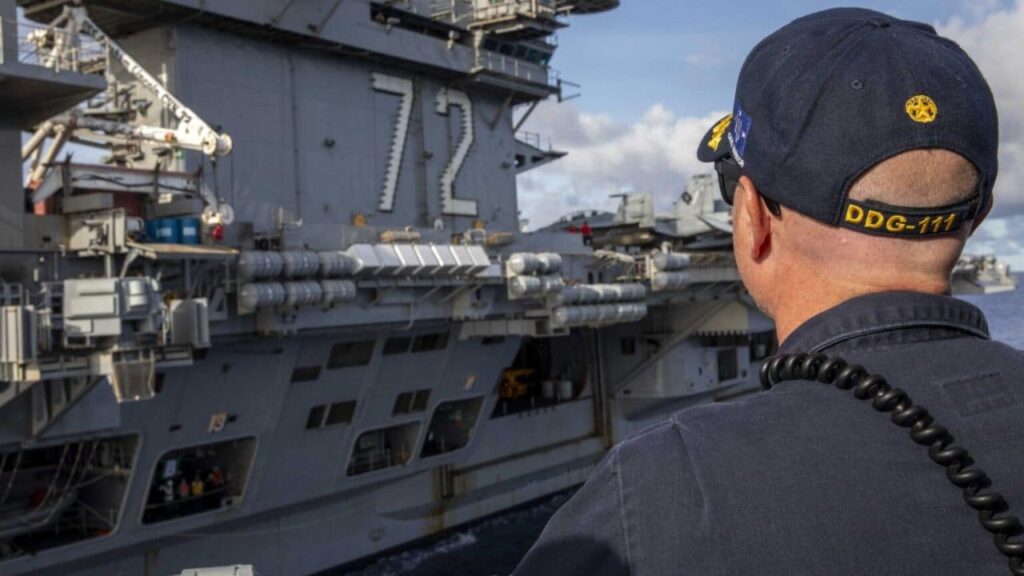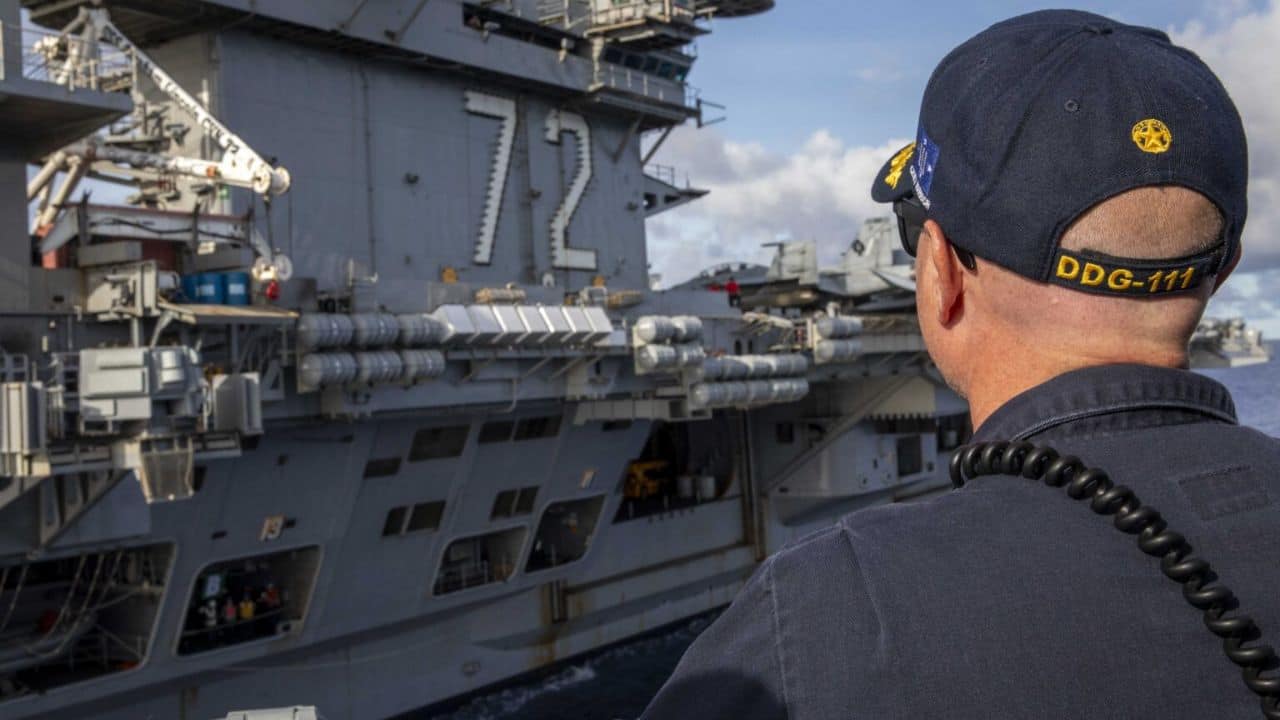USS Abraham Lincoln, Middle East deployment, U.S. Navy, carrier strike group, USS Georgia, F-35C fighters, U.S. Central Command, guided-missile submarine, CENTCOM operations, military strategy
Discover the strategic significance of the USS Abraham Lincoln’s accelerated deployment to the Middle East and the introduction of USS Georgia to CENTCOM. This article delves into the U.S. Navy’s tactical moves, including the powerful capabilities of the F-35C-equipped carrier strike group and the guided-missile submarine, highlighting their roles in bolstering regional security amidst rising tensions.

Accelerated Transit of Carrier USS Abraham Lincoln to the Middle East and the Strategic Deployment of USS Georgia
The U.S. Navy’s aircraft carrier, USS Abraham Lincoln (CVN-72), along with its accompanying strike group, has been ordered to accelerate its transit from the Pacific to the Middle East. This directive, issued by Secretary of Defense Lloyd Austin, underscores the U.S. military’s commitment to bolstering its presence in a region marked by escalating tensions, particularly following the assassination of Hamas leader Ismail Haniyeh in Tehran. The carrier strike group’s rapid redeployment highlights the evolving nature of U.S. strategic military operations and the importance of maintaining a robust naval presence in the volatile Middle East.
Strategic Military Movements and U.S. Commitment to Israel
The decision to hasten the transit of the USS Abraham Lincoln came after a significant conversation between Secretary Austin and Israeli Minister of Defense Yoav Gallant. The discussion reaffirmed the U.S. military’s commitment to Israel, a key ally in the region. The move is seen as a preemptive measure to counter potential retaliatory actions by Iran, which has vowed to respond to the killing of Haniyeh, a prominent figure within Hamas.
The USS Abraham Lincoln Carrier Strike Group, equipped with the advanced F-35C Lightning II Joint Strike Fighters, is a formidable force. The F-35C fighters, part of the “Black Knights” of Marine Fighter Squadron (VMFA) 314, provide the carrier strike group with unparalleled air superiority capabilities. The strike group was initially ordered to head towards the Middle East on August 2, 2024, in response to the escalating tensions. As of the latest reports, the USS Abraham Lincoln was operating in the Sulu Sea, off the coast of the Philippines. Based on previous carrier transits, it is estimated that the journey from the Pacific to the North Arabian Sea and the U.S. 5th Fleet would take approximately seven to nine days.
Coordination with Other Naval Forces
The accelerated movement of the USS Abraham Lincoln raises questions about its operational coordination with the USS Theodore Roosevelt (CVN-71), another aircraft carrier currently deployed in the region. Pentagon spokesman Maj. Gen. Pat Ryder did not confirm whether the two carriers would operate in tandem or if the USS Theodore Roosevelt would be rotated back to the Pacific. The USS Theodore Roosevelt has been deployed for over seven months, and defense officials had previously indicated plans for its return to California. The carrier’s extensive operational history includes nearly 540 days of deployment since 2020, making it one of the most active carriers in the U.S. Navy.
Before the USS Theodore Roosevelt’s arrival in the U.S. Central Command, Secretary Austin had already extended the deployment of the USS Dwight D. Eisenhower (CVN-69) in the Middle East on two occasions. The next East Coast carrier scheduled for deployment is the USS Harry S. Truman (CVN-75), which is currently undergoing its final pre-deployment exercises. These extended deployments reflect the critical need for a sustained U.S. naval presence in the Middle East, a region that remains central to global security concerns.
Introduction of Guided-Missile Submarine USS Georgia to CENTCOM
In addition to the accelerated deployment of the USS Abraham Lincoln, the Pentagon has also ordered the relocation of the Ohio-class guided-missile submarine USS Georgia (SSGN-729) to the U.S. Central Command (CENTCOM) area of operations. The USS Georgia, which is capable of carrying up to 154 Tomahawk Land Attack Missiles and deploying U.S. special operations forces, represents a significant enhancement of the U.S. Navy’s strike capabilities in the region.
The USS Georgia’s movement from the U.S. European Command to CENTCOM was confirmed by a defense official, although the submarine was still operating in the Eastern Mediterranean Sea as of the latest reports. The transit of the USS Georgia through the Suez Canal will mark its entry into the CENTCOM area of responsibility, where it is expected to play a critical role in deterring adversarial actions and providing strategic options for U.S. military planners.
Background on Ohio-Class Submarines and Their Capabilities
The USS Georgia is one of four Ohio-class submarines that have been converted from nuclear ballistic missile submarines (SSBNs) to guided-missile submarines (SSGNs). These submarines were originally designed to carry nuclear ballistic missiles but were repurposed to enhance the U.S. Navy’s conventional strike capabilities. Each Ohio-class SSGN can carry up to 154 Tomahawk cruise missiles, which are capable of striking targets with high precision from great distances. Additionally, these submarines can support special operations missions, making them versatile assets in complex military operations.
The USS Georgia’s deployment to CENTCOM follows the recent return of the guided-missile submarine USS Florida (SSGN-728) from a nearly two-year deployment to the Middle East and the Mediterranean Sea. The USS Florida’s deployment included strikes against Houthi targets in Yemen, demonstrating the critical role that these submarines play in U.S. military operations. The presence of the USS Georgia in the region will further enhance the U.S. Navy’s ability to project power and respond to emerging threats in the Middle East.
Implications for Regional Security
The accelerated deployment of the USS Abraham Lincoln and the introduction of the USS Georgia to CENTCOM underscore the U.S. military’s commitment to maintaining stability in the Middle East. These strategic movements are part of a broader effort to deter adversarial actions by state and non-state actors, particularly in light of recent developments in the region.
The U.S. Navy’s ability to rapidly reposition its forces is a testament to its operational flexibility and global reach. The presence of two aircraft carriers, along with the guided-missile submarine USS Georgia, in the Middle East sends a strong message to both allies and adversaries that the U.S. is prepared to defend its interests and support its partners in the region.
Conclusion
The recent orders for the USS Abraham Lincoln to accelerate its transit to the Middle East and the deployment of the USS Georgia to CENTCOM highlight the U.S. military’s strategic response to escalating tensions in the region. These actions reflect a commitment to maintaining a strong and flexible military presence in the Middle East, a region that remains critical to global security. As the situation continues to evolve, the U.S. Navy’s ability to rapidly deploy and sustain its forces will be crucial in ensuring stability and deterring potential threats.
The continued presence of U.S. naval forces in the Middle East serves as a reminder of the complex and dynamic nature of global security. With multiple carrier strike groups and advanced submarines now positioned in the region, the U.S. is well-prepared to address any challenges that may arise. The deployment of these powerful naval assets not only reinforces U.S. commitments to its allies but also ensures that the U.S. military remains ready to respond to any contingencies in this strategically important region.
Read More
